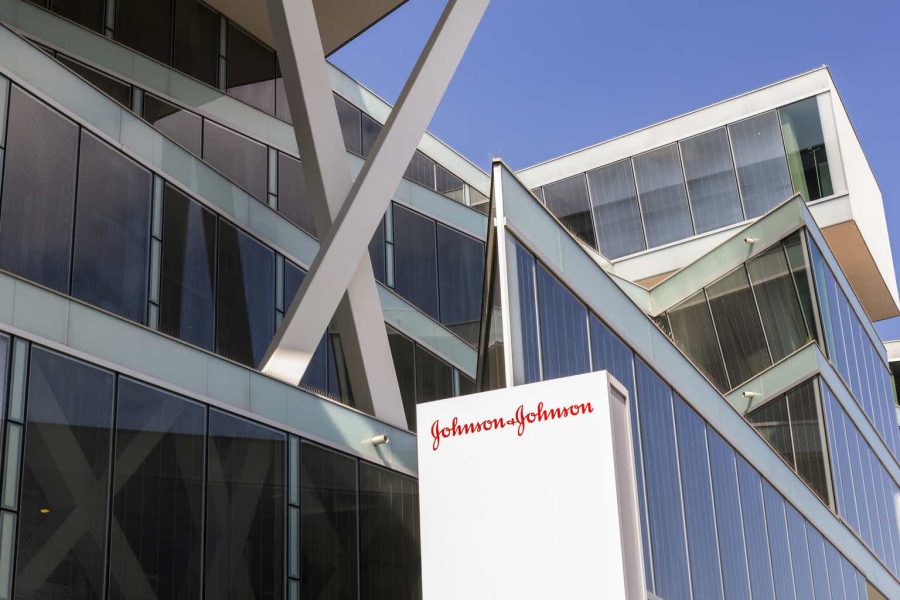July 14, 2024 This Week Top S&P 500 Gainers & Losers
Tesla Q2: The Bottom Is Likely In
Tesla: Time To Take Profits
Microsoft: The Q4 Results Should Surprise You
Tesla: Optimus And FSD Probably Won’t Save The Day
April 23, 2024 Maximizing Profits: When is the Right Time to Sell Your Business?
April 12, 2024 Improve Your Financial Status: A How-To Guide
April 12, 2024 How ZIM Integrated Container Tracking is Revolutionizing Global Trade
March 15, 2024 6 Best Growth Stocks To Buy Now According to Metatrader 5

Johnson & Johnson (JNJ) Stock Forecast for 2024–2028. Sell or Buy?
Updated: July 27, 2024 (13:32)
Sector: HealthcareThe share price of Johnson & Johnson (JNJ) now
50/200 Day Moving Average: $149.01 / $153.37
This figure corresponds to the Average Price over the previous 50/200 days. For Johnson & Johnson stocks, the 50-day moving average is the support level today.
For Johnson & Johnson stocks, the 200-day moving average is the support level today.
Are you interested in Johnson & Johnson stocks and want to buy them, or are they already in your portfolio? If yes, then on this page you will find useful information about the dynamics of the Johnson & Johnson stock price in 2024, 2025, 2026, 2027, 2028. How much will one Johnson & Johnson share be worth in 2024 - 2028?
When should I take profit in Johnson & Johnson stock? When should I record a loss on Johnson & Johnson stock? What are analysts' forecasts for Johnson & Johnson stock? What is the future of Johnson & Johnson stock? We forecast Johnson & Johnson stock performance using neural networks based on historical data on Johnson & Johnson stocks. Also, when forecasting, technical analysis tools are used, world geopolitical and news factors are taken into account.
Johnson & Johnson stock prediction results are shown below and presented in the form of graphs, tables and text information, divided into time intervals. (Next month, 2024, 2025, 2026, 2027 and 2028) The final quotes of the instrument at the close of the previous trading day are a signal to adjust the forecasts for Johnson & Johnson shares. This happens once a day.
Historical and forecast chart of Johnson & Johnson stock
The chart below shows the historical price of Johnson & Johnson stock and a prediction chart for the next month. For convenience, prices are divided by color. Forecast prices include: Optimistic Forecast, Pessimistic Forecast, and Weighted Average Best Forecast. Detailed values for the Johnson & Johnson stock price can be found in the table below.
Long-term forecasts by years.

What to Expect for JNJ Stock Prices: Key Factors and Projections

As we look towards the near future, several significant factors are set to influence Johnson & Johnson's (JNJ) stock rate. Analysts monitoring JNJ stock price predictions should pay close attention to the following events and metrics.
A major driver of JNJ stock forecast is the company's upgraded revenue growth guidance. With expectations now at 6.4% due to the acquisition of Shockwave Medical, this positive adjustment signals robust operational performance and a healthier financial outlook. Such improvements can enhance investor confidence and drive stock prices higher.
Key Influencers and Their Impact
Despite a downward revision of JNJ's adjusted EPS guidance by 6% for 2024, the company still projects a year-over-year increase to $10.02. This positive earnings trend, coupled with a forward P/E ratio of 15.43x—below the five-year average of 16.5x—suggests a potential 7% upside, encouraging a favorable JNJ stock price forecast.
Additionally, Tremfya's impressive 28.3% year-on-year growth could offset potential revenue drops from Stelara's patent expirations. With pending regulatory approvals for Crohn’s disease treatment, Tremfya may significantly boost revenue, lifting investor expectations and stock valuations.
- Revenue Growth and Guidance Upgrades: Indicating stronger future financial health, crucial for stock valuation.
- EPS Guidance and Market Multiples: Attractive earnings outlook and market multiples can drive stock price appreciation.
- Tremfya's Growth and Regulatory Approvals: Tremfya’s growth and potential approvals can mitigate other losses.
- Dependable Dividend Increases: Consistent dividend growth supports investor confidence, especially during market volatility.
Lastly, analysts should remain vigilant about JNJ's litigation risks, particularly surrounding the potential $6.5 billion talcum powder settlement. This could have considerable financial implications, absorbing nearly half of the company's 2023 net income.
In conclusion, those considering if JNJ is a good stock to buy or sell must weigh these interplaying factors. Steady revenue growth, positive earnings forecasts, and dependable dividends suggest a strong outlook for JNJ, though pending litigation poses a risk. These elements combined will guide an accurate JNJ stock price prediction and help determine future investment decisions.
Review the original Analysis

Key Drivers Shaping Johnson & Johnson Stock Forecast

As investors seek clarity on Johnson & Johnson's (JNJ) stock forecast, several pivotal factors and upcoming events appear crucial to stock price movements. Understanding these influences can allow analysts to make informed predictions regarding JNJ stock rates.
Major Influencers in JNJ Stock Forecast
Firstly, the expansion of JNJ's oncology franchise, with impressive revenue growth in drugs like Darzalex and Carvykti, continues to be a cornerstone of their revenue generation. The Phase 3 CARTITUDE-4 study's success in improving multiple myeloma patient survival rates further underscores this sector's critical role.
Additionally, the immunology sector, driven by Stelara and Tremfya, presents robust growth. Stelara alone contributes over 10% of JNJ’s total revenue, and Tremfya’s sales surged by 28.3% YoY. The ongoing demand and regulatory approvals for these drugs ensure a strong revenue stream, boosting investor confidence and JNJ stock value.
The recent $6.48 billion talcum-powder litigation settlement, while a short-term risk, represents a significant step toward removing legal uncertainties. Settlements clear overhangs, making the company more attractive to investors and possibly leading to stock price recovery.
- Strategic acquisitions, such as Shockwave Medical, enhance JNJ's MedTech portfolio, driving innovation and competitive advantage.
- FDA approvals and clinical success remain direct influencers. Potential Tremfya approvals for new indications can significantly widen the market.
- The Kenvue spin-off allows JNJ to focus on high-growth sectors, optimizing operational efficiency and yielding positive market responses.
- Economic conditions and market sentiment naturally play a role, though JNJ’s robust business model offers resilience against broader economic volatility.
By closely monitoring these factors, analysts can forecast Johnson & Johnson stock prices with greater precision. The interplay between strong sector performance, strategic decisions, and external economic factors will guide the future trajectory of JNJ stock.
Review the original Analysis

Johnson & Johnson Stock Prognosis: Unlocking Potential Through New Products and Strategic Moves

Investors keeping an eye on Johnson & Johnson's (JNJ) stock forecast should pay close attention to several key developments expected to influence its price in the near future. The company’s robust new product pipeline, including promising drugs like TREMFYA for ulcerative colitis and RYBREVANT for lung cancer, stands out as a primary driver of potential revenue growth and stock price appreciation.
Strategic Acquisitions and Balanced Growth
Another critical factor is JNJ's strategic acquisition of Shockwave Medical, which positions the company prominently in the cardiovascular market. This move is expected to generate significant revenue synergies and enhance investor confidence, positioning JNJ stock as a potentially lucrative buy. Additionally, balanced growth across JNJ’s Medicine and MedTech segments ensures diversified revenue streams, mitigating potential sector-specific downturns and providing a stable foundation for the company's long-term growth.
Analysts should also consider Johnson & Johnson's aggressive share repurchase program, which has already reduced total shares outstanding by 7.8%. This strategy often boosts the stock price by increasing earnings per share, indicating a strong balance sheet.
However, there are challenges that could pose risks. The company has lowered its EPS guidance due to margin pressures, and there's a noticeable decline in its Infectious Disease segment, particularly with dwindling Covid-19 vaccine revenue. Additionally, slow growth in the APAC region, influenced by economic conditions in China, could temper overall revenue expansion.
In conclusion, analysts forecasting JNJ stock rates should focus on:
- New product launches
- Strategic acquisitions
- Balanced growth in Medicine and MedTech
- Share repurchase programs
- Mitigating challenges from lowered EPS guidance and regional growth issues
By evaluating these factors, analysts can make more accurate predictions on JNJ stock price, determining whether it's a good stock to buy or sell.
Review the original Analysis
If you’re shopping around for top-notch dividend kings to invest in, consider placing Johnson & Johnson (NYSE:JNJ) at the top of your list. For over six decades, this US pharmaceutical titan has been consistently boosting its dividends and currently gifts investors with a quarterly dividend of $1.19 per share. On September 23, it recorded a pretty decent dividend yield of 2.97%.
Recent data suggests that the popularity of Johnson & Johnson (NYSE:JNJ) among hedge funds is on the rise. At the end of Q2 2023, it held a spot in the portfolios of 88 hedge funds, a slight jump from 86 during the previous quarter. What makes this even more significant is that these stakes tally up to a value north of $4.1 billion!
Johnson & Johnson manufactures hygiene products, first aid medicines and medical equipment. Compeed adhesive plasters, Johnson’s Baby care for children, Neutrogena cosmetics, Clean & Clear cleansers and Acuvue contact lenses are the company’s products.
The holding includes 250 companies with three areas of activity: pharmaceuticals, consumer goods and medical equipment manufacturing. Johnson & Johnson products are sold in 175 countries. In 2016, the company earned $ 71.9 billion.
The Johnson brothers originally produced sterile surgical dressings. The first batch went on sale in 1886. Johnson & Johnson’s dressings grew in popularity and were safe and ready to use. In 1916 Johnson & Johnson bought the first textile manufactory. By 1919, the brothers had established a subsidiary in Canada, and by 1924 in the UK. In 1927, the company produced baby cosmetics, feminine hygiene products and adhesive plasters.
Johnson & Johnson daily forecast for a month
| Date | Target | Pes. | Opt. | Vol., % |
|---|---|---|---|---|
| Jul 29 | 161.57 | 160.60 | 162.22 | 1.01 |
| Jul 30 | 161.78 | 161.26 | 162.85 | 0.98 |
| Jul 31 | 160.83 | 160.01 | 162.00 | 1.25 |
| Aug 01 | 161.53 | 161.18 | 162.02 | 0.52 |
| Aug 02 | 162.20 | 161.74 | 163.27 | 0.94 |
| Aug 03 | 162.54 | 161.35 | 163.06 | 1.06 |
| Aug 04 | 162.21 | 161.11 | 163.51 | 1.49 |
| Aug 05 | 162.41 | 161.51 | 163.01 | 0.93 |
| Aug 06 | 161.50 | 160.93 | 162.47 | 0.95 |
| Aug 07 | 160.54 | 160.00 | 161.02 | 0.64 |
| Aug 08 | 159.29 | 158.81 | 160.29 | 0.93 |
| Aug 09 | 159.94 | 158.82 | 161.13 | 1.45 |
| Aug 10 | 160.89 | 160.47 | 161.60 | 0.70 |
| Aug 11 | 160.89 | 160.26 | 161.84 | 0.98 |
| Aug 12 | 162.01 | 161.28 | 162.39 | 0.68 |
| Aug 13 | 162.32 | 161.25 | 163.08 | 1.14 |
| Aug 14 | 163.65 | 162.90 | 164.73 | 1.12 |
| Aug 15 | 164.21 | 162.94 | 164.78 | 1.13 |
| Aug 16 | 163.85 | 163.24 | 164.78 | 0.94 |
| Aug 17 | 164.47 | 163.91 | 164.90 | 0.60 |
| Aug 18 | 164.32 | 163.37 | 165.21 | 1.13 |
| Aug 19 | 165.11 | 164.29 | 166.37 | 1.27 |
| Aug 20 | 165.90 | 164.89 | 166.68 | 1.09 |
| Aug 21 | 165.61 | 164.74 | 166.60 | 1.13 |
| Aug 22 | 164.91 | 164.46 | 165.92 | 0.88 |
| Aug 23 | 164.55 | 163.64 | 165.29 | 1.01 |
| Aug 24 | 163.58 | 162.46 | 164.49 | 1.25 |
| Aug 25 | 162.71 | 161.75 | 163.03 | 0.79 |
| Aug 26 | 162.86 | 162.11 | 163.80 | 1.04 |
| Aug 27 | 163.46 | 162.51 | 164.26 | 1.08 |
Johnson & Johnson Daily Price Targets
Johnson & Johnson Stock Forecast 07-29-2024.
Forecast target price for 07-29-2024: $161.57.
Positive dynamics for Johnson & Johnson shares will prevail with possible volatility of 0.996%.
Pessimistic target level: 160.60
Optimistic target level: 162.22
Johnson & Johnson Stock Forecast 07-30-2024.
Forecast target price for 07-30-2024: $161.78.
Positive dynamics for Johnson & Johnson shares will prevail with possible volatility of 0.973%.
Pessimistic target level: 161.26
Optimistic target level: 162.85
Johnson & Johnson Stock Forecast 07-31-2024.
Forecast target price for 07-31-2024: $160.83.
Negative dynamics for Johnson & Johnson shares will prevail with possible volatility of 1.231%.
Pessimistic target level: 160.01
Optimistic target level: 162.00
Johnson & Johnson Stock Forecast 08-01-2024.
Forecast target price for 08-01-2024: $161.53.
Positive dynamics for Johnson & Johnson shares will prevail with possible volatility of 0.518%.
Pessimistic target level: 161.18
Optimistic target level: 162.02
Johnson & Johnson Stock Forecast 08-02-2024.
Forecast target price for 08-02-2024: $162.20.
Positive dynamics for Johnson & Johnson shares will prevail with possible volatility of 0.933%.
Pessimistic target level: 161.74
Optimistic target level: 163.27
Johnson & Johnson Stock Forecast 08-03-2024.
Forecast target price for 08-03-2024: $162.54.
Positive dynamics for Johnson & Johnson shares will prevail with possible volatility of 1.047%.
Pessimistic target level: 161.35
Optimistic target level: 163.06
JNJ (JNJ) Monthly Stock Prediction for 2024
| Month | Target | Pes. | Opt. | Vol., % |
|---|---|---|---|---|
| Aug. | 162.57 | 159.01 | 163.69 | 2.86 |
| Sep. | 167.40 | 164.33 | 169.81 | 3.22 |
| Oct. | 169.71 | 166.70 | 173.12 | 3.71 |
| Nov. | 170.83 | 166.78 | 173.29 | 3.76 |
| Dec. | 173.29 | 172.09 | 174.85 | 1.58 |
Johnson & Johnson forecast for this year
Johnson & Johnson Stock Prediction for Aug 2024
An uptrend is forecast for this month with an optimal target price of $162.568. Pessimistic: $159.01. Optimistic: $163.69
Johnson & Johnson Stock Prediction for Sep 2024
An uptrend is forecast for this month with an optimal target price of $167.396. Pessimistic: $164.33. Optimistic: $169.81
Johnson & Johnson Stock Prediction for Oct 2024
An uptrend is forecast for this month with an optimal target price of $169.706. Pessimistic: $166.70. Optimistic: $173.12
Johnson & Johnson Stock Prediction for Nov 2024
An uptrend is forecast for this month with an optimal target price of $170.826. Pessimistic: $166.78. Optimistic: $173.29
Johnson & Johnson Stock Prediction for Dec 2024
An uptrend is forecast for this month with an optimal target price of $173.286. Pessimistic: $172.09. Optimistic: $174.85
Johnson & Johnson (JNJ) Monthly Stock Prediction for 2025
| Month | Target | Pes. | Opt. | Vol., % |
|---|---|---|---|---|
| Jan | 173.49 | 171.67 | 176.04 | 2.48 |
| Feb | 175.78 | 172.67 | 179.27 | 3.68 |
| Mar | 177.05 | 175.03 | 181.19 | 3.40 |
| Apr | 175.62 | 173.03 | 177.93 | 2.75 |
| May | 173.46 | 171.79 | 177.46 | 3.20 |
| Jun | 169.29 | 167.77 | 172.09 | 2.51 |
| Jul | 167.36 | 165.66 | 171.03 | 3.14 |
| Aug | 166.76 | 165.06 | 169.51 | 2.63 |
| Sep | 164.71 | 163.03 | 166.69 | 2.19 |
| Oct | 168.37 | 166.90 | 171.60 | 2.74 |
| Nov | 172.91 | 170.06 | 176.39 | 3.59 |
| Dec | 171.41 | 169.86 | 172.85 | 1.73 |
Johnson & Johnson (JNJ) Monthly Stock Prediction for 2026
| Month | Target | Pes. | Opt. | Vol., % |
|---|---|---|---|---|
| Jan | 172.64 | 168.86 | 176.63 | 4.40 |
| Feb | 170.41 | 169.19 | 174.04 | 2.79 |
| Mar | 170.36 | 166.68 | 171.69 | 2.92 |
| Apr | 171.54 | 167.52 | 175.35 | 4.46 |
| May | 171.28 | 168.46 | 175.19 | 3.84 |
| Jun | 168.61 | 165.93 | 170.89 | 2.90 |
| Jul | 170.33 | 167.72 | 171.66 | 2.29 |
| Aug | 171.15 | 168.32 | 174.38 | 3.47 |
| Sep | 171.71 | 169.24 | 173.21 | 2.29 |
| Oct | 169.91 | 165.93 | 172.71 | 3.93 |
| Nov | 170.57 | 167.50 | 173.80 | 3.62 |
| Dec | 169.50 | 167.97 | 173.01 | 2.91 |
Johnson & Johnson (JNJ) Monthly Stock Prediction for 2027
| Month | Target | Pes. | Opt. | Vol., % |
|---|---|---|---|---|
| Jan | 165.68 | 164.24 | 169.26 | 2.97 |
| Feb | 161.41 | 159.04 | 163.98 | 3.01 |
| Mar | 160.44 | 157.46 | 161.50 | 2.50 |
| Apr | 161.84 | 158.97 | 164.89 | 3.59 |
| May | 164.51 | 161.00 | 166.73 | 3.43 |
| Jun | 168.85 | 167.13 | 172.85 | 3.31 |
| Jul | 173.76 | 172.09 | 175.69 | 2.05 |
| Aug | 174.70 | 172.24 | 177.58 | 3.01 |
| Sep | 172.24 | 169.24 | 175.54 | 3.59 |
| Oct | 175.91 | 174.75 | 177.28 | 1.43 |
| Nov | 176.43 | 174.11 | 179.77 | 3.15 |
| Dec | 173.58 | 172.38 | 177.43 | 2.85 |
Johnson & Johnson (JNJ) Monthly Stock Prediction for 2028
| Month | Target | Pes. | Opt. | Vol., % |
|---|---|---|---|---|
| Jan | 175.45 | 173.13 | 179.35 | 3.46 |
| Feb | 174.77 | 171.78 | 177.75 | 3.36 |
| Mar | 175.71 | 174.08 | 178.61 | 2.54 |
| Apr | 175.39 | 172.08 | 177.92 | 3.28 |
| May | 178.45 | 175.18 | 182.62 | 4.07 |
| Jun | 182.46 | 179.83 | 184.49 | 2.52 |
| Jul | 182.41 | 180.33 | 184.05 | 2.02 |
| Aug | 182.79 | 180.87 | 184.60 | 2.02 |
| Sep | 180.60 | 177.51 | 184.66 | 3.87 |
| Oct | 185.25 | 181.59 | 187.42 | 3.11 |
| Nov | 187.53 | 184.55 | 191.75 | 3.76 |
| Dec | 186.46 | 183.78 | 188.98 | 2.75 |
Johnson & Johnson information and performance
ONE JOHNSON & JOHNSON PLZ, NEW BRUNSWICK, NJ, US
Market capitalization of the Johnson & Johnson is the total market value of all issued shares of a company. It is calculated by the formula multiplying the number of JNJ shares in the company outstanding by the market price of one share.
EBITDA of Johnson & Johnson is earnings before interest, income tax and depreciation of assets.
P/E ratio (price to earnings) - shows the ratio between the price of a share and the company's profit
Price/earnings to growth
Dividend Per Share is a financial indicator equal to the ratio of the company's net profit available for distribution to the annual average of ordinary shares.
Dividend yield is a ratio that shows how much a company pays in dividends each year at the stock price.
EPS shows how much of the net profit is accounted for by the common share.
Trailing P/E depends on what has already been done. It uses the current share price and divides it by the total earnings per share for the last 12 months.
Forward P/E uses projections of future earnings instead of final numbers.
Enterprise Value (EV) /Revenue
The EV / EBITDA ratio shows the ratio of the cost (EV) to its profit before tax, interest and amortization (EBITDA).
Number of issued ordinary shares
Number of freely tradable shares
Shares Short Prior Month - the number of shares in short positions in the last month.
Johnson & Johnson (JNJ) stock dividend
Johnson & Johnson last paid dividends on 08/27/2024. The next scheduled payment will be on 09/10/2024. The amount of dividends is $4.81 per share. If the date of the next dividend payment has not been updated, it means that the issuer has not yet announced the exact payment. As soon as information becomes available, we will immediately update the data. Bookmark our portal to stay updated.
Last Split Date: 01/01/1970
Splitting of shares is an increase in the number of securities of the issuing company circulating on the market due to a decrease in their value at constant capitalization.
For example, a 5: 1 ratio means that the value of one share will decrease 5 times, the total amount will increase 5 times. It is important to understand that this procedure does not change the capitalization of the company, as well as the total value of assets held in private hands.
















































